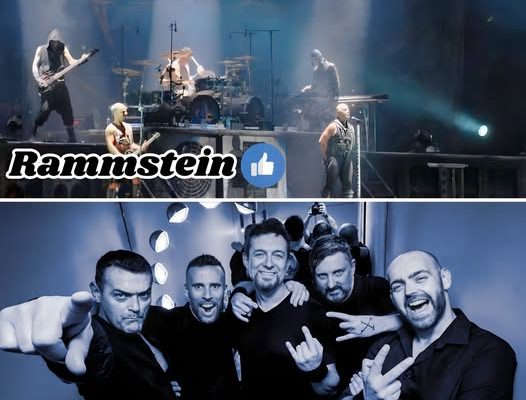Imagine this: colossal walls of mechanized distortion rising and collapsing in waves, molten circuits of pulse and feedback, flesh-hewn vocals tearing through the cacophony — that is the arena in which Rammstein and Pitchshifter collide. To call it a “sound clash” does scant justice: it is more a confrontation of elemental forces, a forging of steel and electricity in the furnace of sonic extremity. In one corner stands Rammstein, the titanic hammer of industrial metal, stomping through machines with the relentless discipline of Neue Deutsche Härte. In the other corner, Pitchshifter, the mutating hybrid, mixing electronica, nu‑metal attitudes, breakbeat dynamism, and experimental audacity. What happens when these two beasts share the same battlefield? The result is a maelstrom: brutal, inventive, unnerving, enthralling.
From the moment their riffs collide, the listener is caught between tectonic plates of sound. Rammstein’s approach is methodical, monolithic: two guitars locked in unison, powering massive, simple, pulverizing riffs that stride with the weight of an industrial march. Their rhythms are not flashy, but punishing — Christoph Schneider’s drums rarely break into complex fills; instead they drive with a primal, stomping pulse. Beneath that sits the keyboards and electronics: not shimmering ornamentation, but steel‑grimed textures, sampled clangs, mechanical hums, and brooding atmospherics. Till Lindemann’s voice rises like a furnace — deep, controlled, theatrical, declamatory, with a grim, Germanic gravitas. The sonic aesthetic is austere, muscular, and ritualistic. Over the years, Rammstein has sometimes softened margins or introduced pop sensitivities, but their core remains built on brute force + industrial machinery.
Pitchshifter, by contrast, is a mutagenic shockwave. Formed at the intersection of metal and electronics, they embraced sampling, breakbeats, drum programming, glitch, and aggressive guitars that turn inside out, bent toward noise. Their songs may lean heavily on electronics, but when the guitars hit, they hit hard — often tuning down to monstrous depths, layering distortion and grit over shifting rhythmic foundations. Their vocals hop between clean, snarl, shout, scream, even whispered glitch fragments. As their sound evolved, they leaned further into fusion: industrial, nu‑metal, electronic, drum’n’bass, and experimental noise all swirl in their palette. Their early work especially wears its industrial roots plainly, but with a restless urge toward mutation.
Now imagine constructing a composite arena: start with Rammstein’s vast, monolithic riffing as a backdrop, then overlay it with Pitchshifter’s shifting electronics, glitch pulses, and rhythmic fractures. In such a clash, the rigid becomes fluid, the mechanical becomes alive. The guitar wall that Rammstein builds becomes a foundation, but Pitchshifter’s pulses crack it open, injecting unexpected jolts and off‑beat accents. Drum patterns may move from steady industrial stomp to syncopated breakbeat interludes, bridging the gap between the machine march and the dancefloor jerk.
Vocally, the tension is electric. Lindemann’s voice, measured and commanding, stands like a pillar of molten basalt — and then occasionally a sudden vocal shift from the Pitchshifter side, a scorned scream or distorted expletive, shoves through the mix like a dagger. In refrains, dual vocals might interplay: Lindemann intoning gravely in German, while a counterpart snarls or mashes in English or half‑spoken electronic fragments. The contrast emphasizes depth and texture, not so much friendly harmony as a conversation in conflicting tonality.
The production space of this clash is immense, but also dangerously tight. The mix must balance massive guitar presence without smothering the electronics; the low end must carry both the crushing riffs and the subsonic bass gambits of the electronic side. Textural moments—sampled industrial clangs, reverse noise, glitch artifacts—can lurk in the corners, spontaneously surfacing between riffs. Ambient breaks interrupt the breakdowns: a slow fade to silence, then a field recording of machinery, or whispered voices, before the next onslaught. Moments of calm are rare but vital — when the massive wall drops to just a single distorted synth or processed vocal — so that when the full might returns, it hits like a tidal wave.
In the architectural sense, this clash is less song than a ruin in motion. The structures are built, broken, reassembled. Some sections lean more Rammstein — solid, unyielding, march‑like. Other passages twist into Pitchshifter’s territory: rhythmic experiments, glitch breaks, looping motifs, sudden dropouts and rebuilds. A chorus might open with Lindemann’s stoic “Wir …” yelled over the guitar, then fold in layers of electronic sweep, breakbeats, synthesizer arpeggios, until the entire mass spins into a distorted crescendo.
Lyrically and thematically, this collision magnifies tensions. Rammstein often delves into ironies of power, identity, desire, war, industrial alienation, sometimes with a sense of stoic detachment or bleak spectacle. Pitchshifter’s lyrical bent is more fragmented, more reactive, more internet-age angst, media critique, dystopia, body politics — laced with paranoia, irony, and internal fracture. In a joint piece, the lyrics might alternate between declarative German proclamations and glitch-shattered English fragments, a dialectic of the monumental and the fractured. Perhaps a verse mourns the ruined factory, the next bursts into a swirl of digital rage, or a sampled voiceover becomes a chorus line, refracted.
If this collision were staged live, the visuals would match the drama. Rammstein’s tradition of pyrotechnics, fire spouts, industrial set pieces, darkness, iron scaffolding, dramatic lighting — overlaid with video projections of glitch art, data streams, abstract electronic visuals, strobing coded grids — would create a theater of machinery, flesh, and data. The ending might not resolve with a fade-out, but collapse: the stage flickers; the machines shudder; one last burst of noise; the audience enveloped in white-out feedback.
From the listener’s vantage, this is not merely a mash-up of styles but a dialectic: stability vs mutation, ritual vs disruption, mass vs detail. Rammstein brings the mass, the weight, the inevitability. Pitchshifter brings the fissures, the interruptions, the sparks. Taken together, the clash doesn’t cancel either; it elevates both. The solidity of the riffs grounds the experimental flights; the electronics add risks, fractures, surprises that keep the massive structures from calcifying into tedium.
One can imagine several movements in such a piece. The opening could lean into Rammstein’s realm: heavy guitar drones, industrial hum, echoing percussion. Then one by one, the electronics intrude — a sub bass wobble, a glitch surge, a reversed sample bleeding through. Midway, transitions deepen: guitars drop out, electronics take over, beat stutters, a weird breakdown, then the guitar returns, stronger, but changed. A bridge might reassemble fragments: tribal drums, processed vocal loops, ambient decays, before the final crash. The final section unleashes everything: full guitars, full electronics, dual vocals, walls of sound, subs, with interwoven artifacts flying across the stereo field. And finally, after the deluge, silence — or a meager synthetic echo, trailing off.
The emotional range in this shared space is wider than either band often allows. There’s awe and terror in sheer heaviness; there’s disquiet and vertigo in the cracked electronics; there’s catharsis in combining irrevocable mass with shifting light. Such a collision is unlikely to be “pretty” in any conventional sense — but it is thrilling, daring, visceral.
It helps to anchor this in reference points. Rammstein’s mature work — albums like Mutter or recent tracks like Deutschland — already thread in atmospheric passages, cinematic dynamics, and electronic flourishes. Meanwhile, Pitchshifter’s evolution, from early industrial grind toward later fusion and electronic experimentation, shows their willingness to break rigid boundariesOne can hear, in Pitchshifter’s discography, the seeds of glitch, the seeds of breakbeat, the seeds of internal deconstruction, all riding over heavy guitars. A combined version of, say, Rammstein’s Feuer Frei! injected with Pitchshifter’s breakbeat, glitch echo, and electronic reverse delay — it’s not pure fan fantasy; it’s a thought experiment: what if the fonts of discipline and mutation met head-on?
Of course, it’s not seamless. The great risk is dilution: the guitars might drown the electronics, or the electronics might feel grafted rather than integrated. Too much rigidity means the experimental moments feel tacked-on; too much fragmentation means the power collapses. The art is in balance: allowing each side its domain but letting them bleed into one another, letting cross-pollination occur. The transitions must breathe; the textures must shift; the listener must feel both rooted and unsettled.
In that sense, this clash is not about dominance but synthesis. It is not Rammstein vs Pitchshifter — it is Rammstein with Pitchshifter, a third hybrid being born in the collision. It is the forging of a new industrial-metal-electronic beast, one that carries the dignity of weight and the thrill of rupture.
To walk away from such a track, the listener would not simply hear two influences; they would carry residues: the echo of a gigantic riff you can still feel in your bones, but also the tickle of a glitch echo in your ear; the momentary disorientation as electronics fold into metal; the vocal scars of fractured proclamation; the afterimage of collapsing architecture in sound. That is the grand sound clash — not a trivial crossover, but a violent, generative meeting, where the mechanical becomes alive, and the digital finds flesh.



